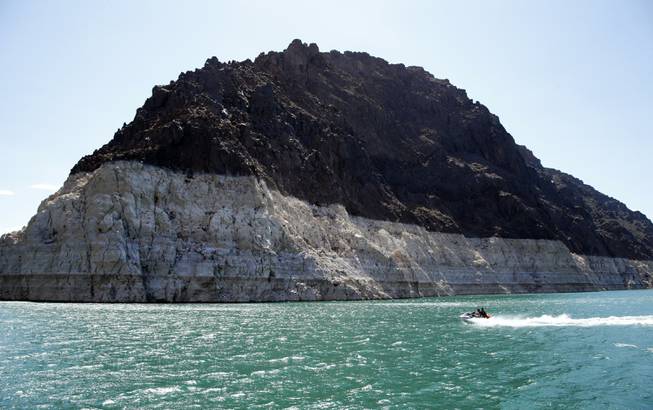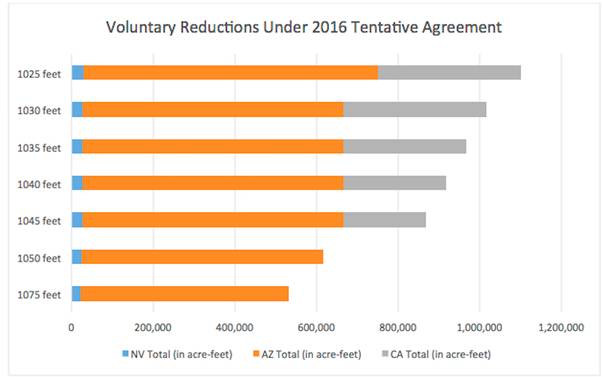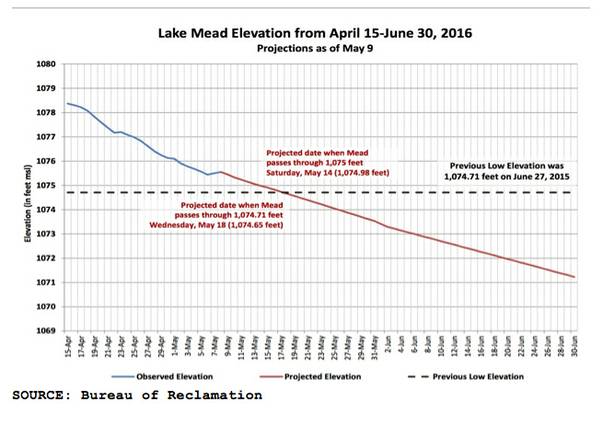
John Locher / AP
In this July 17, 2014, photo, recreational boaters ride by a bathtub ring that delineates the high water mark at Lake Mead.
Wednesday, May 11, 2016 | 2 a.m.
Lake Mead is expected to surpass its historic low after next Wednesday. By the end of June, it is expected to have dropped to its lowest level since the man-made reservoir was created by the completion of the Hoover Dam in 1935. And as the elevation drops, Nevada, Arizona and California are working out a new framework for acceptable reductions in water they receive.
While the federal agency charged with overseeing Western water management says it is unlikely that states will need to reduce water in 2017, the next year could present a bleaker picture.
Although estimates change with resource planning, the U.S. Bureau of Reclamation says there is a 56 percent chance states will be asked to voluntarily reduce their lake allocations in 2018.
Such a scenario provides the backdrop as the three states at the Colorado River’s lower basin renegotiate what voluntary reductions in water supply they would accept to stave off declining Lake Mead elevations. Late last month, details of a tentative agreement emerged, with a significant development.
California, which has not taken cuts in the past, could potentially accept reductions in its allotment. Under the agreement, which expands on a 2007 deal between the states, Arizona would continue to share the largest burden of cuts.
Nevada officials say the state would largely be unaffected by the cuts. But it has a stake in keeping Lake Mead, the source of most of the valley’s drinking water, above 1,000 feet.
“(The deal) would protect critical elevations in Lake Mead,” said John Entsminger, who heads Southern Nevada Water Authority.
Lake Mead’s elevation is hovering above 1,075 feet, and it is projected to decline below that elevation beginning on Saturday.
That level is significant because it is the first threshold for the tiered reductions. It does not, however, trigger reductions immediately. It is likely that the lake elevation will rise above 1,075 feet after the summer months are over, and voluntary reductions are only triggered by lake elevations on Jan. 1.
The tentative deal, which must receive approval from California water districts, SNWA’s board and several Arizona entities, is unlikely to be implemented for at least another year.
Tanya Trujillo, executive director of the Colorado River Board of California, said it’s premature to say if the state would have voluntary reductions in the final deal. Trujillo, who is negotiating for California, said that the talks involve several components, including how much water can be stored at the lake.
“We’re trying to work with Arizona and Nevada on a series of agreements that would be beneficial to all three states,” she said of the ongoing negotiations. “We think that the process of trying to work collaboratively is better than trying to negotiate against each other in courts or in Congress.”
In the current draft form, Nevada would reduce its allocation by 21,000 acre-feet of water if the lake dipped below 1,075 feet and take a maximum reduction of 30,000 acre-feet if Lake Mead fell below 1,025 feet. For reference, one acre-foot of water can meet the needs of two Las Vegas homes for more than a year.
The maximum reductions for Arizona would be 720,000 acre-feet and for California, the cuts amount to 350,000 acre-feet.
Nevada’s reductions are small compared with other states, as is its total draw from the lake. Nevada is entitled to 300,000 acre-feet of water from the Colorado River, whereas California’s annual allotment is 4.4 million acre-feet per year and Arizona’s is 2.8 million, the result of an infamous 1922 interstate deal.
Although the lake provides Las Vegas with a large portion of its water, officials say they are prepared for the reductions.
“We are building a water delivery system that will ensure a secure water supply regardless of lake levels in Lake Mead,” said Entsminger, who leads SNWA operations as general manager.
Bronson Mack, a spokesperson for the water authority, said the region would not have to take “drastic steps” like rationing.
“We got our house in order very early on,” Mack said.
For years, Nevada has been banking much of its water.
“It’s like your savings account,” Mack said. “We’re not socking it away for a rainy day. We’re socking it away for a dry day.”
Last year, the water authority did not use roughly a quarter of its apportionment, which allowed the agency to store it for later use. As of 2016, the authority had accumulated more than 1 million acre-feet, spread out in aquifers from Arizona to Las Vegas.
In addition to water security, Lake Mead is vital for sending electricity to municipalities across the West. With the water already low, the Hoover Dam is at half its capacity, according to Rose Davis, a spokesperson at the Bureau of Reclamation.
“Without water, we can’t generate power,” Davis said. “The whole system needs to survive for everybody. (The states) recognize that the health of the Colorado River system and Lake Mead, not only for their future deliveries, but for power generation, is all interconnected. Everyone has something at stake here.”
The dam cannot generate power once the elevation level hits about 900 feet.



Join the Discussion:
Check this out for a full explanation of our conversion to the LiveFyre commenting system and instructions on how to sign up for an account.
Full comments policy